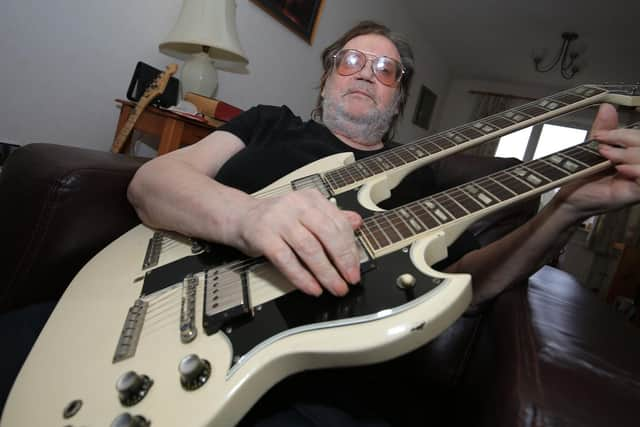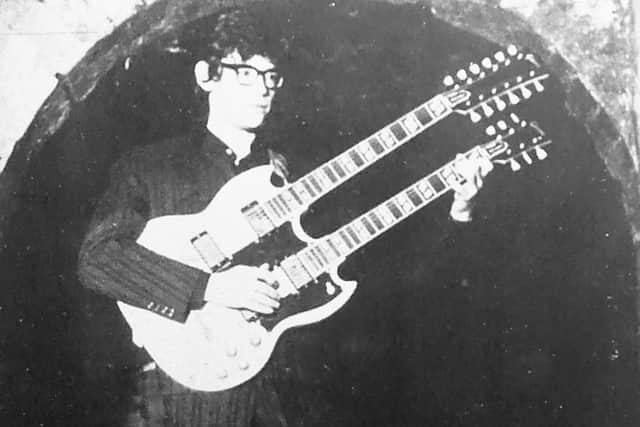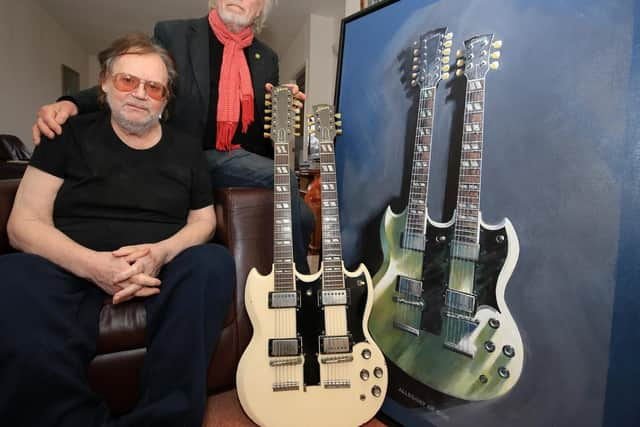Why the Sheffield guitar Led Zeppelin’s Jimmy Page wants to buy is a work of art


Frank – who lives in Gleadless, once played with singer Dave Berry and is regarded as a musician who could have matched the careers of Eric Clapton and Keith Richards if he’d wished – was the first person to have the instrument’s model shipped to the UK, placing a special order with the Gibson factory in America in 1963.
Today the rare item is owned by Phil Brodie, another former Berry colleague, who used to play with the Sheffield band Bitter Suite and has amassed one of Britain’s biggest collections of vintage guitars. He commissioned the painter Roy Ridsdale, who has previously explored the city’s heritage by sketching the objects held at Kelham Island Museum, to depict the white double neck variety life-size in oils and acrylics.


Advertisement
Hide AdAdvertisement
Hide AdFrank has already been presented with a reproduction print of the piece, while getting the chance to play his old guitar – fitted with a six-string neck and a 12-string one – for the first time in 15 years.
Roy’s work is, he says, ‘brilliant’.
“It captures it,” he says, recalling his days touring with the instrument in the 1960s. “It’s been halfway round the world with me, that thing. We used to do Holland now and again – Dave Berry was pretty big over there. I’m sure lots of people have got pictures of it.”
The guitar’s attraction, he says, is that it ‘looks so cool’. He saw one advertised in the Gibson catalogue, and with help from his father managed to get the necessary £400 together to order it.


“I just pondered on what I could do with it. I thought ‘Oh yeah, that’s something’. The six-string neck, the lower one, looks like a regular Gibson Les Paul, but the 12-string allowed me to get fired up to do other things.”
Advertisement
Hide AdAdvertisement
Hide AdGuitars, Roy says, are ‘incredibly powerful’. “I hope I did it in such a way that people see it as a visual experience rather than purely waiting for it to make a sound. I used light to give it drama. I elevated it visually and dignified it as a work of art as well as a musical instrument. It’s not just rock gods. But the image of somebody with one of these machines is just stunning.”
He ‘did lots of drawings’ of the guitar, took photographs and did colour studies. “There’s so much detail there. Phil said ‘Would you be able to paint one of my guitars?’ and I picked out one which is quite special. The problem with doing this guitar was not to make it look like a technical illustration in a book. It’s very much a painting. The guitar is iconic.”
Roy – who in 2017 put on an exhibition called The Aesthetic Allure of Functional Objects at the Millennium Gallery – hopes the painting, titled Allegory of God, will remind people of Frank’s talents. “He is a great performer. It’s very important Sheffield remembers him. He could have competed with Keith Richards, Eric Clapton etc, but he walked away from it all.”


Phil bought the guitar after it had spent years in a money-lender’s shop. The instrument was put on display in Sheffield’s ill-fated National Centre for Popular Music. “I nearly lost it when the place closed,” he says. “It’s been locked up in my collection since 2003.”
Advertisement
Hide AdAdvertisement
Hide AdIn 2018 he met up with Jimmy Page on Wardour Street in London, when he was asked if he would consider selling – Page is a connoisseur of double neck guitars, using one during live performances of Stairway To Heaven.
“I said, ‘I’m not sure’,” Phil says. “I haven’t sold it because of a romantic notion it’s part of Sheffield history.”
Page, Frank says, bought a twin neck model after he did. “We were going to do an album together in the 60s, but it didn’t happen.”
Frank gigged at the Pheasant Inn, at Sheffield Lane Top, every Friday for two decades, but hasn't played for four years because of an injury. “I broke my left shoulder and the break never healed, so it caused me some problems.”
Advertisement
Hide AdAdvertisement
Hide AdHe still keeps guitars at home, though – so won’t rule out a return completely. “I’ve envisaged it quite a few times but I don't think it’s going to happen yet.”
Roy thinks he is still more than capable of entertaining a crowd, however – as he watched Frank play the white Gibson when the painting was shown to him.
“We gave him the guitar, obviously it wasn’t plugged in, and he sat it on his knee,” says Roy. “His whole persona changed, his face just lit up. Every time he was plucking a string he matched it with a facial expression, it was lovely to see that. It’s still in his blood.”
Visit www.royridsdale.com for more on Roy's art.